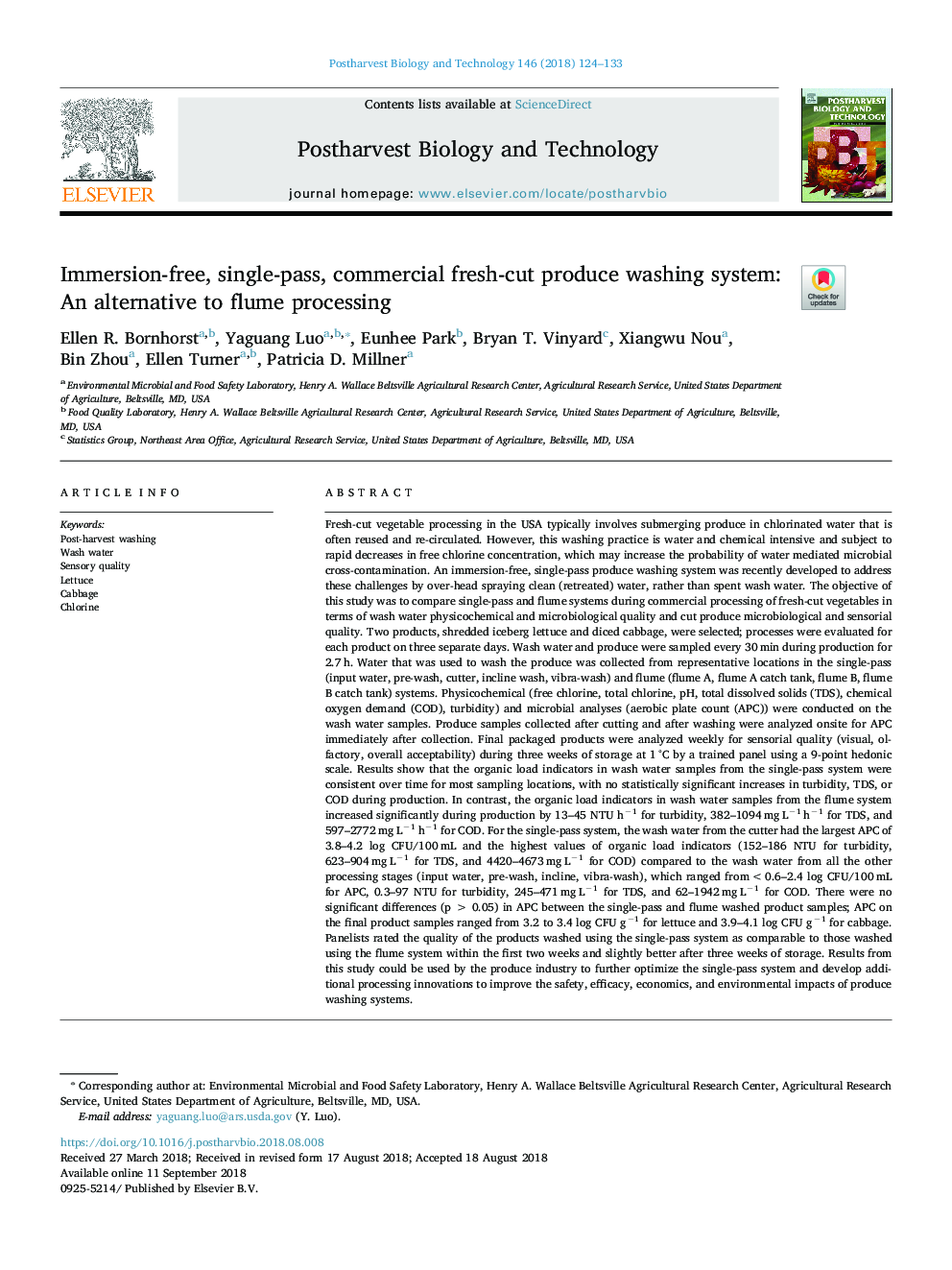| کد مقاله | کد نشریه | سال انتشار | مقاله انگلیسی | نسخه تمام متن |
|---|---|---|---|---|
| 10117106 | 1624948 | 2018 | 10 صفحه PDF | دانلود رایگان |
عنوان انگلیسی مقاله ISI
Immersion-free, single-pass, commercial fresh-cut produce washing system: An alternative to flume processing
ترجمه فارسی عنوان
سیستم شستشوی شستشوی شغلی رایگان، بدون مجوز، یکبار مصرف، جایگزین برای پردازش فلوم
دانلود مقاله + سفارش ترجمه
دانلود مقاله ISI انگلیسی
رایگان برای ایرانیان
کلمات کلیدی
شستن بعد از برداشت، آب را بشویید کیفیت حسی، کاهو، کلم، کلر،
موضوعات مرتبط
علوم زیستی و بیوفناوری
علوم کشاورزی و بیولوژیک
علوم زراعت و اصلاح نباتات
چکیده انگلیسی
Fresh-cut vegetable processing in the USA typically involves submerging produce in chlorinated water that is often reused and re-circulated. However, this washing practice is water and chemical intensive and subject to rapid decreases in free chlorine concentration, which may increase the probability of water mediated microbial cross-contamination. An immersion-free, single-pass produce washing system was recently developed to address these challenges by over-head spraying clean (retreated) water, rather than spent wash water. The objective of this study was to compare single-pass and flume systems during commercial processing of fresh-cut vegetables in terms of wash water physicochemical and microbiological quality and cut produce microbiological and sensorial quality. Two products, shredded iceberg lettuce and diced cabbage, were selected; processes were evaluated for each product on three separate days. Wash water and produce were sampled every 30âmin during production for 2.7âh. Water that was used to wash the produce was collected from representative locations in the single-pass (input water, pre-wash, cutter, incline wash, vibra-wash) and flume (flume A, flume A catch tank, flume B, flume B catch tank) systems. Physicochemical (free chlorine, total chlorine, pH, total dissolved solids (TDS), chemical oxygen demand (COD), turbidity) and microbial analyses (aerobic plate count (APC)) were conducted on the wash water samples. Produce samples collected after cutting and after washing were analyzed onsite for APC immediately after collection. Final packaged products were analyzed weekly for sensorial quality (visual, olfactory, overall acceptability) during three weeks of storage at 1â°C by a trained panel using a 9-point hedonic scale. Results show that the organic load indicators in wash water samples from the single-pass system were consistent over time for most sampling locations, with no statistically significant increases in turbidity, TDS, or COD during production. In contrast, the organic load indicators in wash water samples from the flume system increased significantly during production by 13-45 NTU hâ1 for turbidity, 382-1094âmgâLâ1âhâ1 for TDS, and 597-2772âmgâLâ1âhâ1 for COD. For the single-pass system, the wash water from the cutter had the largest APC of 3.8-4.2 log CFU/100âmL and the highest values of organic load indicators (152-186 NTU for turbidity, 623-904âmgâLâ1 for TDS, and 4420-4673âmgâLâ1 for COD) compared to the wash water from all the other processing stages (input water, pre-wash, incline, vibra-wash), which ranged from <0.6-2.4 log CFU/100âmL for APC, 0.3-97 NTU for turbidity, 245-471âmgâLâ1 for TDS, and 62-1942âmgâLâ1 for COD. There were no significant differences (pâ>â0.05) in APC between the single-pass and flume washed product samples; APC on the final product samples ranged from 3.2 to 3.4 log CFU gâ1 for lettuce and 3.9-4.1 log CFU gâ1 for cabbage. Panelists rated the quality of the products washed using the single-pass system as comparable to those washed using the flume system within the first two weeks and slightly better after three weeks of storage. Results from this study could be used by the produce industry to further optimize the single-pass system and develop additional processing innovations to improve the safety, efficacy, economics, and environmental impacts of produce washing systems.
ناشر
Database: Elsevier - ScienceDirect (ساینس دایرکت)
Journal: Postharvest Biology and Technology - Volume 146, December 2018, Pages 124-133
Journal: Postharvest Biology and Technology - Volume 146, December 2018, Pages 124-133
نویسندگان
Ellen R. Bornhorst, Yaguang Luo, Eunhee Park, Bryan T. Vinyard, Xiangwu Nou, Bin Zhou, Ellen Turner, Patricia D. Millner,
